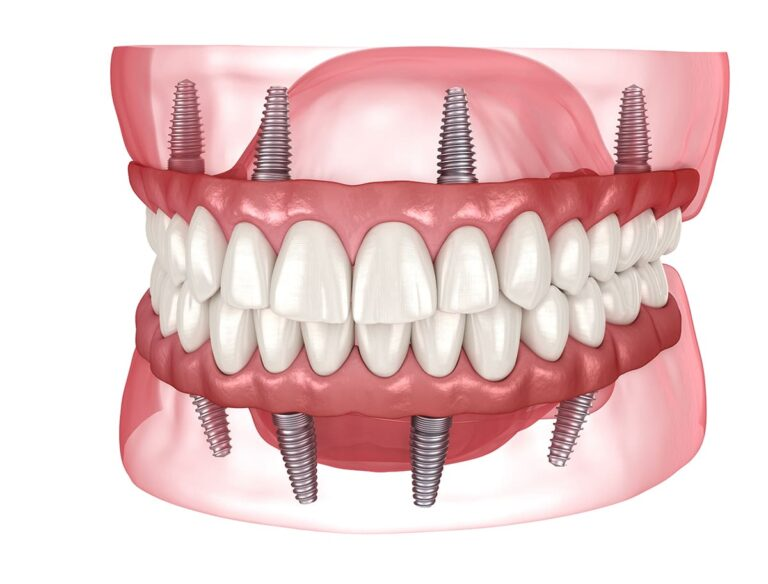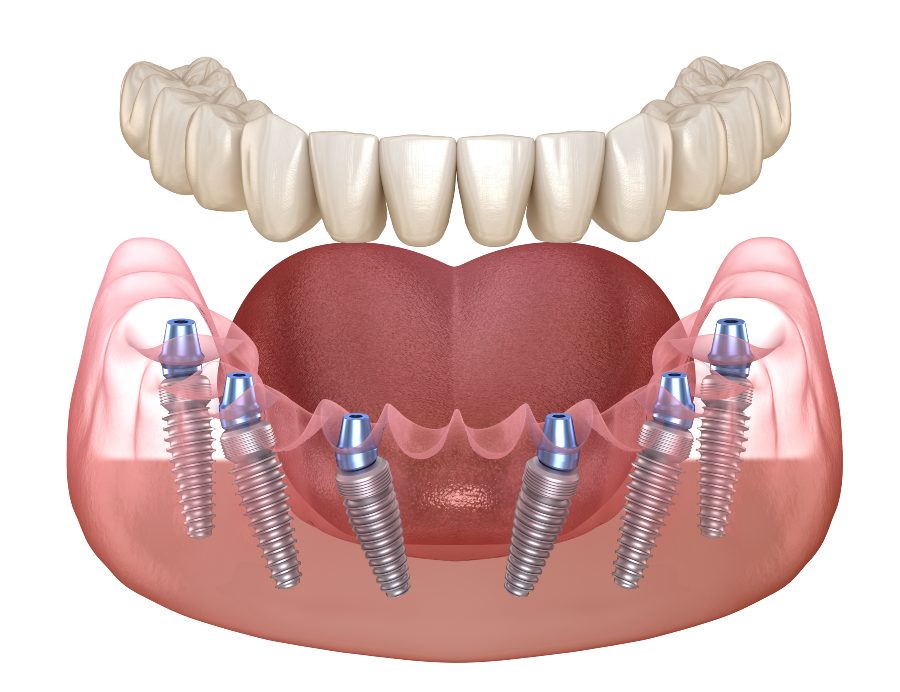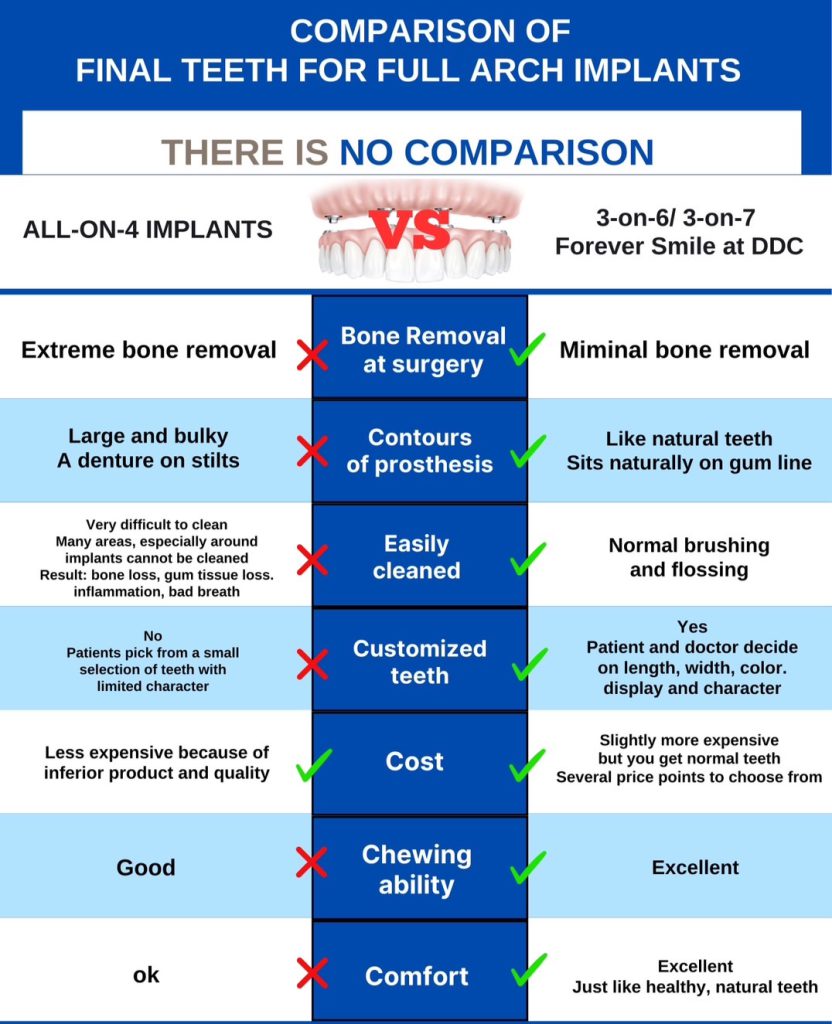What are 3 on 6 Dental Implants?
The 3 on 6™ dental implant system involves the use of three dental bridges, each securely attached to a set of six dental implants. This innovative restoration method functions similarly to a traditional dental bridge but distinguishes itself by utilizing artificial roots in place of natural teeth.
This approach is particularly well-suited for comprehensive full-mouth reconstruction, as it effectively reinstates the natural functionality of the teeth by evenly distributing the forces exerted during biting and chewing. In certain instances, it may be necessary to perform bone grafting procedures to enhance the strength of the implant site.
The 3 on 6™ dental implant system has revolutionized smile restoration, making it a viable and cost-effective option for many individuals who were previously faced with the choice between dentures or living with a dissatisfying smile.
These dental implants represent an excellent solution for those missing an entire arch of teeth and serve as an alternative to traditional permanent dentures, which typically rely on two to four implants for support. Furthermore, their design eliminates the need for synthetic gums, resulting in a more aesthetically pleasing appearance.
The 3 on 6™ Process
The 3 on 6™ dental implant process is a comprehensive treatment plan designed to replace multiple missing teeth with a fixed dental prosthesis supported by a specific configuration of dental implants. Here’s an overview of the steps involved in the 3 on 6™ process:
Step 1. Initial Consultation:
The process commences with an initial consultation with a certified dentist who will assess your oral health. During this appointment, the dentist will conduct X-ray and CT scans to evaluate your suitability for the 3 on 6 dental implant treatment. Additionally, financial and payment options will be discussed, and the timeline for starting the treatment will be determined.
Step 2. Implant Surgery:
At your second appointment, the dentist will perform the implant surgery. While local anesthesia is commonly used for this procedure, you may opt for general anesthesia if you have anxiety or specific preferences. Following the surgery, there is a healing period, which can range from a few weeks to several months. During this phase, a removable denture will be provided to maintain your appearance while your gums heal.
Your dental team will utilize scans of your teeth or pre-designed models to create a customized smile for you. You will have the opportunity to provide input on the shade and design of your new teeth.
Step 3. Temporary Restoration:
After your implants have properly healed, your dentist will remove the denture, attach abutments, and affix temporary bridges. This allows you to assess the appearance and functionality of your new teeth before the dentist orders the more durable ceramic replacements. You will wear these temporary bridges for a brief period, usually a week or two, and then meet with your dentist to share your feedback. If you have any concerns or wish to make adjustments to your smile, your dentist will make note of your preferences and communicate them to their team.
Step 4. Final Bridge Placement:
In the final step, your dentist will schedule one more appointment to place your zirconia bridges and ensure they meet your expectations. This appointment marks the completion of the 3 on 6 dental implant process, leaving you with a fully restored and functional smile.
The 3 on 6™ process is known for its ability to restore the functionality and aesthetics of a full arch of teeth, providing a long-lasting and cost-effective solution for individuals with multiple missing teeth. However, it’s crucial to consult with a qualified dental professional to determine if this treatment is suitable for your specific dental needs and to receive personalized care throughout the process.
How Long Do 3 on 6 Dental Implants Last?
With proper maintenance and care, 3 on 6 dental implants are designed to last a lifetime. It’s essential to maintain good oral hygiene, including regular flossing and brushing, and to avoid habits like smoking and drug use, as these practices can impact both bone density and the long-term durability of the implants. However, when properly cared for, 3 on 6 dental implants are designed to be a long-term and durable solution for replacing missing teeth. Here are some factors that can influence the longevity of 3 on 6 dental implants:
Oral Hygiene: Good oral hygiene practices, such as regular brushing, flossing, and professional dental cleanings, are essential to the success and longevity of dental implants. Keeping the surrounding gum tissues and remaining natural teeth healthy is crucial.
Overall Health: General health conditions can impact the success of dental implants. Conditions like uncontrolled diabetes or certain autoimmune disorders can increase the risk of complications and affect implant longevity.
Lifestyle Habits: Smoking and excessive alcohol consumption can negatively impact the health of dental implants and increase the risk of implant failure. It’s advisable to avoid these habits for the best implant longevity.
Maintenance: Regular follow-up visits with your dental professional are important for monitoring the health of your implants. They can identify and address any potential issues early on, which can help extend the lifespan of the implants.
Quality of Materials and Placement: The quality of the dental implants themselves, as well as the precision of the surgical placement, can influence how long they last. High-quality materials and skilled implant placement increase the chances of long-term success.
In general, with proper care and maintenance, 3 on 6 dental implants can last for many years, often decades. Some individuals may even have them last a lifetime. However, it’s important to be aware that there can be occasional issues, such as implant loosening or complications, which may require adjustments or additional procedures to address.
Regular communication with your dental specialist and adherence to their recommended oral care routine is crucial for ensuring the best possible outcome and longevity for your 3 on 6 dental implants.
All-on-4 implants vs 3 on 6 implants
When comparing All-on-4 implants to 3 on 6 implants, it’s important to note some key distinctions:


1. Implant Configuration:
All-on-4: This approach involves using four dental implants per dental arch to support a complete set of replacement teeth. It typically includes a prosthesis that spans the entire arch, which can include synthetic gums for a more natural appearance.
3 on 6: In the 3 on 6 implant method, three dental implants are placed per dental arch, with each implant supporting a pair of replacement teeth. This method usually does not incorporate synthetic gums.
2. Clinical Considerations:
All-on-4: This option is often recommended when a patient has limited bone volume in the jaw. The strategic placement of four implants provides stability even in cases of reduced bone density. It’s also suitable for patients with multiple dental problems, such as missing teeth, insufficient bone volume, and tissue issues.
3 on 6: The 3 on 6 implant procedure may be chosen for patients with adequate bone density and suitable dental conditions. It can be a more conservative option, as it uses fewer implants, making it suitable for cases with sufficient natural support.
3. Personalization:
The choice between All-on-4 and 3 on 6 implants should be driven by a thorough clinical evaluation by a dental professional. Factors like bone density, the overall oral health of the patient, and specific treatment goals play a crucial role in determining which approach is best.
In summary, while both All-on-4 and 3 on 6 implants offer solutions for replacing missing teeth with artificial roots and crowns, the decision should be based on clinical assessment rather than personal preference. All-on-4 is well-suited for cases with limited bone support and complex dental issues, while 3 on 6 may be a more conservative choice for patients with adequate bone density and fewer dental concerns. Consulting with a qualified dental specialist is essential to determine the most appropriate treatment plan for your individual needs.

Dental Implant Cases
Case example 1:
Full Mouth Implant 3-on-8 / 3-on-7 / 3-on-6

Case example 2:
Full Mouth Implant 3-on-8 / 3-on-7 / 3-on-6

Case example 3:
Full Mouth Implant 3-on-8 / 3-on-7 / 3-on-6

Patient Video Reviews:
Full Mouth Implant 3-on-8 / 3-on-7 / 3-on-6

